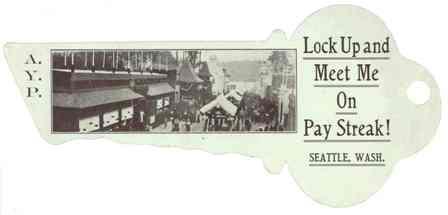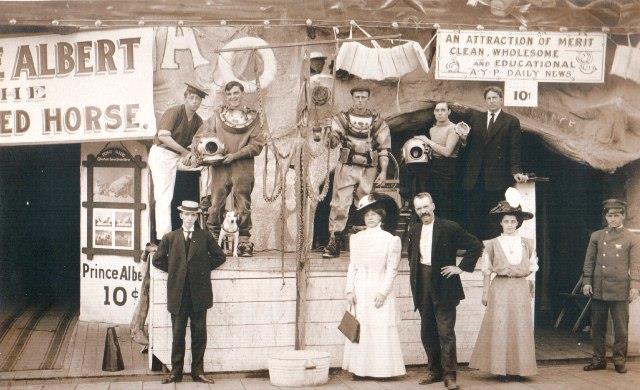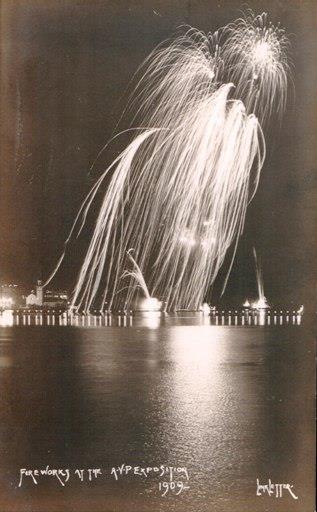Alaska-Yukon-Pacific Exposition - Images of the Fair
On the Pay Streak
Die-cut postcard, anon.
Fascinating and frivolous, educational and exploitive, inspirational, a place of indulgence - the Pay Streak, so beloved in 1909, defies easy characterization today. It was popular with visitors from all walks of life and would pique our interest if we could stroll it now. One could enjoy scientific and engineering displays or sample exotic cultures through architecture, performance, artifact, food, and merchandise. Industry and history were on display in live and static exhibits. Premature infants that would have been lost in the best medical facilities of the day were saved. Visitors got photographs of themselves alongside camels, pet ducks, talking horses, giant pianos, bagpipers, and exotic dancers. Local ethnic and regional organizations were able to have their moments of celebrity. At busy times the barkers' cries, thrill riders' shrieks, wailing music and machinery's clatter must have created a joyous cacophony overlaid with pungent aromas and the sight of swirling skirts and swaying bodies.

Postcard, anon. Visitors could actually pan for gold, eat moose meat, and experience a Klondyke dance hall.
The first modern international expositions did not include an amusement area, but entertainment has been linked with fairs throughout history and their inclusion in world's fairs was inevitable. At the Centennial Exposition (Philadelphia, 1876), an amusement camp developed on its own outside the gates; a licentious free-for-all to fleece and debauch the unwary. Paris' 1889 exposition helped define amusement areas as an integrated part of expositions and the World's Columbian Exposition (Chicago, 1893) codified arrangements for American expositions. The term 'Midway' as we use it today comes from the Chicago fair's Midway Plaisance, midway between the main exhibition areas, parkland that was set aside for entertainment at the exposition.
Subsequent American expositions often coined their own names to go with the fair's theme. The AYPE's Pay Streak is a gold prospector's term, referring to veins or layers of gravel from which a worthwhile ("paying") concentration of gold ore can be extracted. The AYPE's location on the University grounds necessitated a ban on the serving of alchoholic beverages.
As Robert Rydell explains in his classic All the World's a Fair, the Chicago Midway served several exemplary purposes. It brought the uncontrolled commercial zone into a regulated area where visitors could have an experience more commensurate with the ideals of the exposition. It helped finance the exposition by sharing revenue. It contributed to educational goals by allowing commercial vendors to offer what might be termed "infotainment" today. It enhanced the anthropological offerings by creating an area with space for large, outdoor, living displays, in addition to that which had been set aside for conventional displays. And even at the large Chicago fair, the legitimacy of the international venue was enhanced by the displays of nations that had no other representation. On the AYPE's Pay Streak, this was an especially important contribution.
Major shows and exhibits were classified under the system that defined the entire exposition, and were eligible for the same sort of awards that displays presented in the main exposition buildings could earn. There was a wide variety of venue types and sizes, from large shows that had been presented at many of the leading international expositions, to small local proprietors with stands that are little different from those at street fairs today. Most information and imagery available today is about the large venues on the main avenue, which was divided into two parts by what is today's Burke-Gilman trail. The Upper Pay Streak ran along Fifteenth Avenue NE from 40th St. to Pacific St, while the Lower Pay Streak was in the area now occupied by the western half of the University Medical complex and the various Marine Sciences facilities.
Oakes Photo Co. (attr.)
Diving exhibit on the Pay Streak. Note the octopus prop at center. The show to the left is Prince Albert, the Educated Horse.
The beautiful Streets of Tokio was one of several venues on the fairgrounds in classical Japanese form. It included a Tea Garden, Geisha dancing, and an open market.
Lloyd G. Linkletter
Fireworks displays were a regular event at the foot of the Pay Streak. These spectacular shows included special pictorial displays such as "Collision of Locomotives", "Bombardment of Moro Castle", and "American Flag". This type of display can be seen today during the summertime at Victoria, Canada's Butchart Gardens.
Sources include A-Y-P Daily News, 6/8/09





